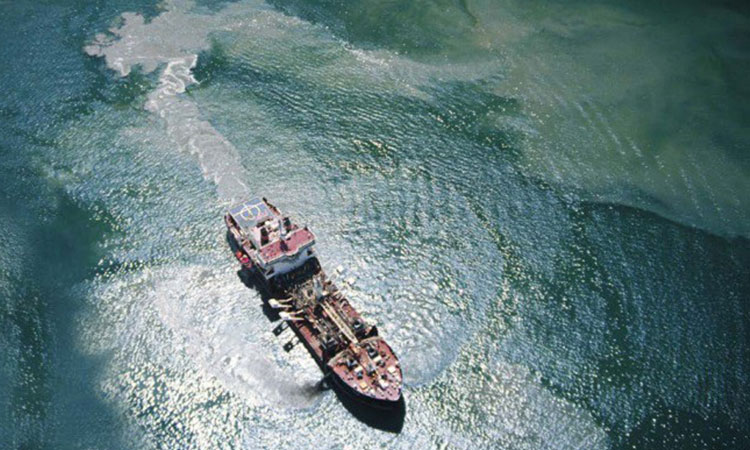Introduction
BioPetroClean has successfully completed a project for bilge water treatment. BPC’s novel biological method allowed a highly efficient depletion of TOC, COD, ammonia and phenols, as well as other contaminants. The biological process was straight forward, without any pre− treatment, and resulted with a significantly lower sludge level, allowing a more effective and economical post− treatment.
One of the WWTP situated near the Rotterdam port, Holland, operates a biological process for cleaning bilge water, as well as other wastewater types. The plant has encountered some operational difficulties due to the high sensitivity of the system, as well as the high sludge levels produced in the process. Furthermore, it was also facing a growing need to increase the plant’s capacities. These reasons have motivated the plant’s team to seek for an alternative method, more suitable for high contamination level and still efficient and economical.
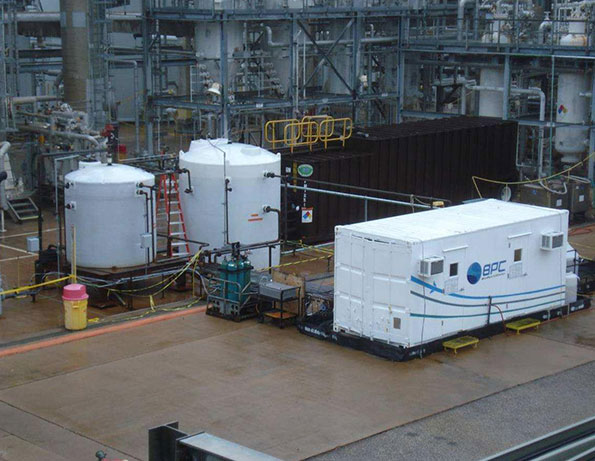
Figure 1 : BPC-ACT pilot system for treating bilge water
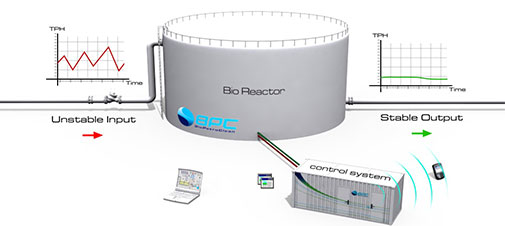
Figure 2 : A schematic description of BPC- ACTTM technology: The bioreactor receives a highly contaminated (and sometimes fluctuating) inlet, and releases a low and stable outlet. The control unit continuously monitors the process
BPC’s ACT Technology
BioPetroClean’s innovative biological method for wastewater treatment is an elegant and simple way to overcome the existing challenges of currently common biological methods. The method, known as the Automated Chemostat TreatmentTM (ACT), is based on maintaining a pre−selected bacterial “cocktail” at a stable and low concentration, while monitoring the system with a fully automated control unit.
BPC’s Solution to the client’s need
Considering the client’s desire to decrease the sludge levels and increase the hydraulic and organic loads on the existing wastewater treatment process, BPC offered a two steps solution. In the first step BPC will build and operate a pilot system that will demonstrate the ability of the BPC−ACTTM method to effectively treat bilge water. Based on the results of the pilot, the client could then decide to move on to the second step of building a full−scale system.
Pilot Configuration and Implementation
As a preliminary step, the client’s water was sampled and analyzed in BPC’s laboratories in order to develop an optimal biodegradation process. The lab analysis was performed in two stages:
- Water characterization
- Biological treatment
Upon completion of the laboratory analysis, BPC has erected and operated the pilot system at the client’s site and under actual environmental conditions. The pilot system included the BPC−ACTTM biological system, followed by sand filtration or ultra−filtration post− treatments for final fine tuning of the water quality.
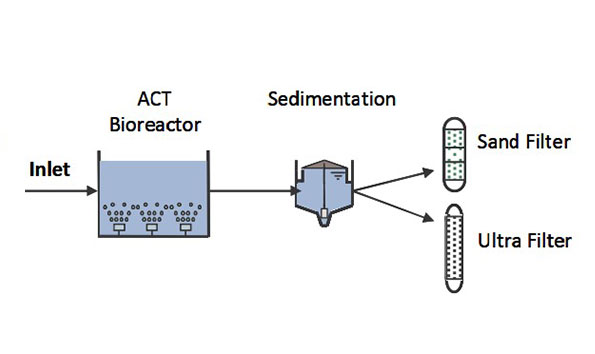
Figure 3: The pilot system for bilge water treatment included the BPC-ACTTM system, followed by a sedimentation step and either a sand filter or an ultrafilter.
The pilot system worked in a continuous flow for 12 weeks. The system was dedicated to the treatment of common bilge water, as well as bilge water originated from a fire accident (which is characterized with higher contamination level). The water was pumped into the ACT bioreactor, connected to BPC’s control unit. This fully automated control unit maintained controlled conditions throughout the process and allowed optimal environmental conditions for the biological treatment. It also generated reports and system logs during and after the process.
The water quality before and after the biological treatment was continuously measured and compared to the clients desired levels. Furthermore, two filtration methods were tested as a final polish for the process. Their efficiency in decreasing the contaminants level was compared to their prospective capital and operational costs.
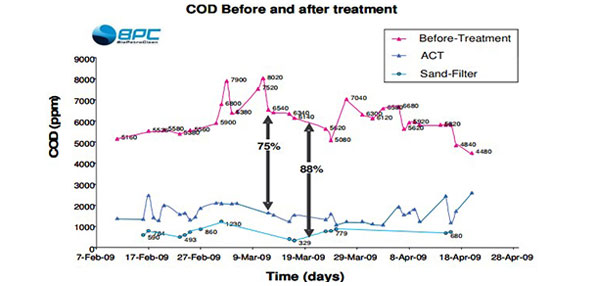
Figure 4 : COD levels before and after treatments. The BPC-ACTTM treatment alone led to a 75% decrease in COD. The combination of BPC-ACTTM followed by a sand filter led to an 88% decrease.
Pilot Results
As shown in figure 4, the biological treatment led to a 75% decrease in COD (from 6,100 ppm to 1500 ppm). The additional filtration step lowered the COD to 700 ppm or 63 ppm by sand or ultra filter, respectively.
Similarly, TPH was significantly reduced from 66 ppm to 0.1 ppm, again lower than the required levels (<1 ppm), as shown in table 1 below. The initial phenol level of 246 ppm is considered very high comparing to “normal” bilge water levels.
Nevertheless the BPC−ACTTM treatment was extremely efficient. The biological treatment alone led to a complete reduction of phenols, exceeding the client’s desired value of less than 1 ppm. The total nitrogen and phosphorous levels were also decreased below the client’s desired value after the biological and the filtration steps. The TSS level was increased during the biological step due to formation of biomass during the biodegradation. However, the level was low enough to be efficiently filtered with a simple sand filter.
| Table 1 : Water Characteristics before and after BPC's treatment | ||||||||
|---|---|---|---|---|---|---|---|---|
| Parameters (ppm) | Desired Values | Before Treatment | BPC-ACT™ | BPC-ACT™ + Sand Filtration | BPC-ACT™ + Ultra Filtration | |||
| Value±Error | Reduction(%) | Value±Error | Reduction(%) | Value | Reduction(%) | |||
| Oil (TPH) | <1 | 66±7 | 6±2 | 91 | 5±2 | 92 | 0.1 | 99.8 |
| COD | <500 | 6096±141 | 1627±69 | 73 | 701±60 | 88 | 63 | 99 |
| Phenol | <1 | 246±64 | 0.1±0 | 100 | 0.1±0 | 100 | 0.1 | 100 |
| Total N | <15 | 207±5 | 131±3 | 37 | 74±4 | 64 | 6.4 | 97 |
| Total P | <2 | 10±0.8 | *13±1 | --- | 2.5±0.4 | 75 | 0.52 | 95 |
| TSS | <25 | 51±33 | 428.6±81.9 | --- | 2.6±2.1 | 95 | ND | --- |
MLSS and Viability Tests
In parallel to the water quality analyses, water samples from both the BPC−ACTTM process and the client’s activated sludge (AS) process were tested for microbial characteristics. The MLSS levels of each sample were qualitatively measured. Figure 5 demonstrates the significantly lower MLSS level, formed during the BPC− ACTTM process in comparison with the level formed during the AS process.
The viability of the microbial populations in each sample was calculated based on a viable count method (90% in BPC−ACTTM and 65% in AS). This difference is also visually demonstrated in the following figure, where live bacteria were stained in green and dead bacteria were stained in red. Both MLSS and viability tests indicate that the biodegradation efficiency in the BPC−ACTTM method is higher.
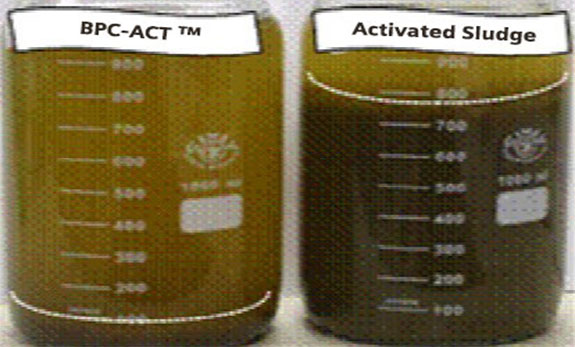
Figure 5 : A visual demonstration of the MLSS formed in the BPC-ACTTM process, in comparison to that of the activated sludge process.
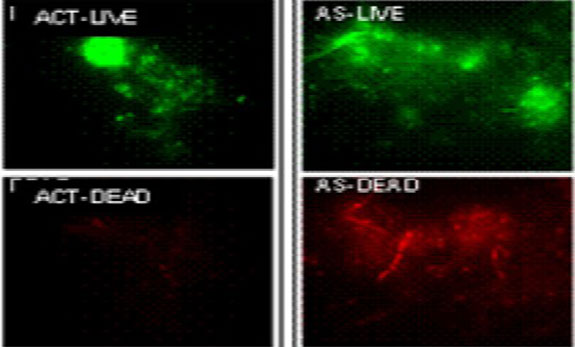
Figure 6: Comparison of the bacterial viability in BPC-ACTTM and in Activated sludge (AS). The viability in the BPC-ACTTM sample was 90% while the viability in AS was 65%.
The Valuable Contribution of BPC
BPC’s approach for the client’s challenges was simple and elegant. The system tested in this pilot was advantageous for the following reasons:
- High efficiency − The BPC−ACTTM technology enabled cleaning of highly contaminated water to a purity level that meets with the client’s desired values and the treatment did not require any chemical or physical pre−treatment.
- Full automation − The BPC−ACTTM control unit enables a fully automated, easy to operate process that eliminates the need for highly skilled operators.
- Cost reduction − The significant decrease in sludge production, as well as the high efficiency and simplicity of the process can contribute to a large decrease in client’s operational cost.
The Next Step- Permanent System
Bilge water must be cleaned from traces of oil and organic chemicals before it is discharged to the sea. The currently available biological methods for treating the dissolved contaminants in bilge water are often cumbersome and sensitive to inlet fluctuations. Furthermore they are based on the concept of maintaining a high cell concentration that results in high sludge levels. These translate to operational difficulties and to high operational expenses. As an efficient and economical alternative, BPC offers its innovative BPC−ACTTM technology. The fully automated system is easy to implement, highly efficient and is cost effective. This case study describes the pilot trial for implementing the BPC− ACT method on bilge water. Based on its successful completion, the customer is now interested in the erection of a full on−going BPC−ACT system.
Summary
BPC offers a simple and efficient solution for upgrading old effluent treatment systems to a level that will allow for safe recycling or release of water, as well as lower overall costs and less maintenance. The BPC-ACT solution can easily be integrated into currently existing infrastructure, resulting in a more cost effective and environmentally friendly wastewater treatment. The retrofit process is quick and relatively painless, and leads to a superior a more stable means of effluent treatment.
Optimization Statistics
From the designers and engineers who are creating the next generation of web and mobile experiences, to anyone putting a website together for the first time. We provide elegant solutions that set new standards for online publishing.
Digital technology has made our world more transparent and interconnected, posing new challenges and opportunities for every business. A holistic, user-centric perspective is what truly sets one apart. together for the first time. We provide elegant solutions.
From the designers and engineers who are creating the next generation of web and mobile experiences, to anyone putting a website together for the first time. We provide elegant solutions that set new standards for online publishing.
We Will Be Useful to You
From the designers and engineers who are creating the next generation of web and mobile experiences, to anyone putting a website together for the first time.
Digital technology has made our world more transparent and interconnected, posing new challenges and opportunities for every business. As your budget progresses and evolves, continue referring to your SMART objectives. Stay focused and remember your goals – they will always inform what your next step will be!
From the designers and engineers who are creating the next generation of web and mobile experiences, to anyone putting a website together for the first time. We provide elegant solutions that set new standards for online publishing.
As your budget progresses and evolves, continue referring to your SMART objectives. Stay focused and remember your goals – they will always inform what your next step will be!


